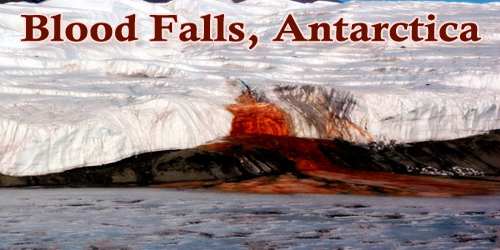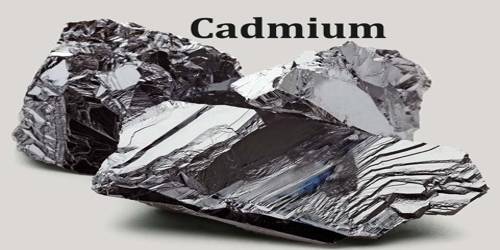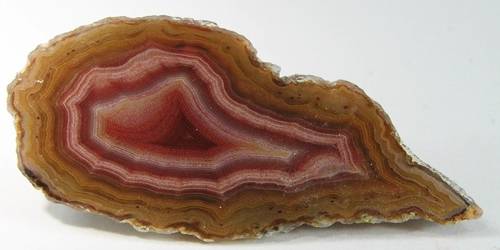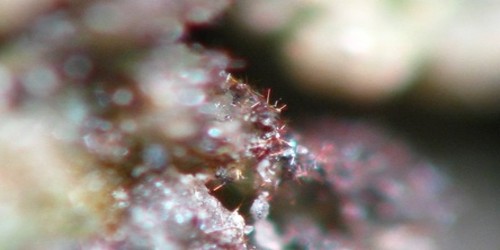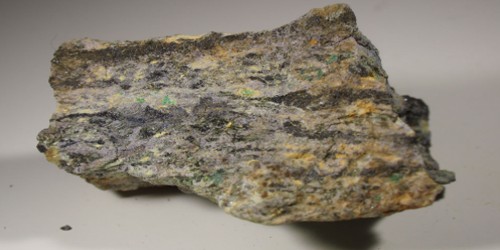“Blood Falls” is an outflow of an iron oxide-tainted plume of saltwater, flowing from the tongue of Taylor Glacier onto the ice-covered surface of West Lake Bonney in the Taylor Valley of the McMurdo Dry Valleys in Victoria Land, East Antarctica. Geologists originally thought the red color was due to algae but the truth is actually much more interesting.
Five million years ago, sea levels rose, flooding East Antarctica and forming a salty lake. Millions of years later, glaciers formed on top of the lake, cutting it off from the rest of the continent meaning that the water in “Blood Falls” is something of an aqueous time capsule, preserved 400 meters (1,300 ft) underground. As the glaciers on top of the lake began to freeze, the water below became even saltier. Today, the salt content of the subglacial lake under Blood Falls is three times saltier than seawater and too salty to freeze. The subglacial lake that feeds Blood Falls is trapped beneath a quarter mile of ice.
The reddish deposit was found in 1911 by the Australian geologist Griffith Taylor, who first explored the valley that bears his name. The Antarctica pioneers first attributed the red color to red algae, but later it was proven to be due to iron oxides.
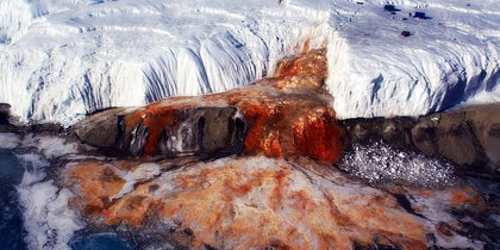
(Blood Falls -Taylor Glacier)
Blood Falls source lake is not actually red. Its subglacial conditions exclude oxygen and light but include large amounts of iron. The salty, iron-rich water only becomes red as it interacts with the oxygen-rich surface environment at the falls, a complex chemical reaction called oxidation. Reddish particles form as a result of a chemical reaction between iron and oxygen. The presence of salt increases the rate of this reaction, allowing the salty water at Blood Falls to appear bright red as it trickles down the glacier.
Researchers out of the University of Alaska Fairbanks and Colorado College used radio-echo sounding, also known as ice-penetrating radar, to map what lay beneath the surface of Taylor Glacier. By moving antennae in grid-like patterns, the research team was able to identify the source of the flow, revealing “a complex network of subglacial rivers and a subglacial lake all filled with brine high in iron, giving the falls its reddish tint,” explains National Geographic. When the salty, iron-rich water bleeds out of the openings in the glacier and first comes in contact with the air, the bright red color is produced. When the falls aren’t flowing, they turn a dried rust color, like a scab covering a wound. It seems these falls can make you shiver from more than just the cold.
According to geomicrobiologist Jill Mikucki at the University of Tennessee, water samples from Blood Falls contained at least 17 different types of microbes, and almost no oxygen. An explanation may be that the microbes use sulfate as a catalyst to respire with ferric ions and metabolize the trace levels of organic matter trapped with them. Such a metabolic process had never before been observed in nature. A puzzling observation is the coexistence of Fe2+ and SO2−4 ions under anoxic conditions. No sulfide anions (HS−) are found in the system. This suggests an intricate and poorly understood interaction between the sulfur and the iron biochemical cycles.
“Blood Falls” is a landform of interest to Arctic explorers, glaciologists, limnologists, and microbiologists. Astrobiologists, people who study the possibilities for life outside Earth, are also interested in Blood Falls and its unusual microbe community. Blood Falls provides one model for how life can exist under the ice in very harsh environments no oxygen, no light, sub-zero temperatures. Many astrobiologists think that Jupiter’s moon Europa, for example, may hold a massive liquid ocean beneath its icy crust. If life exists on Europa, it may share characteristics with the bacteria of Blood Falls.
The study of harsh environments on Earth is useful to understand the range of conditions to which life can adapt and to advance assessment of the possibility of life elsewhere in the solar system, in places such as Mars or Europa, an ice-covered moon of Jupiter. Scientists of the NASA Astrobiology Institute speculate that these worlds could contain subglacial liquid water environments favorable to hosting elementary forms of life, which would be better protected at depth from ultraviolet and cosmic radiation than on the surface.
Information Sources:
